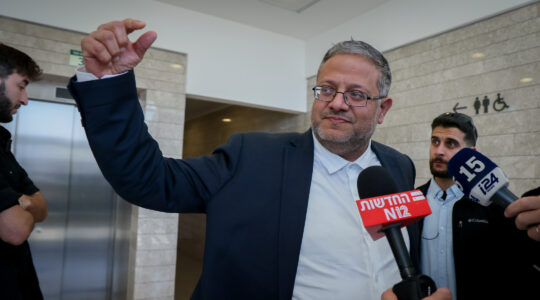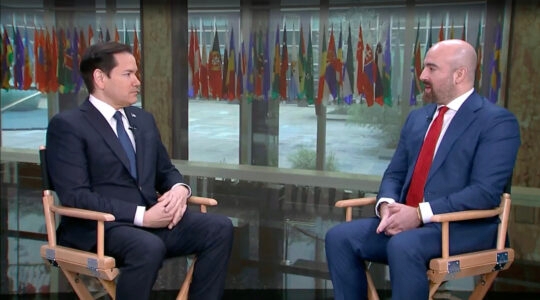The spring issue of Contact: The Journal of the Steinhardt Foundation for Jewish Life enlists a dozen of the foremost thinkers on Jewish philanthropy to talk about the state of fund raising. With the Steinhardt Foundation’s permission, The Fundermentalist will republish over the next two weeks pieces from the likes of the foundation’s president, Bob Aronson, the president of the Andrea and Charles Bronfman Philanthropies, Jeffrey Solomon, philanthropy guru Phyllis Cook and academic Amy Sales.
The first piece comes from Aronson, who talks about what he has learned in 35 years of fundraising in the Jewish world, both as the head of a major Jewish federation in Detroit, the president of the Birthright Israel Foundation and as an advisor to some of the country’s most influential private Jewish philanthropists such as Michael Steinhardt and the late Bill Davidson. He gives four tips on how to raise money effectively. Check back tomorrow when we bring you the next piece.
WHAT I’VE LEARNED ABOUT RAISING MONEY FROM JEWS
by ROBERT P. ARONSONIn 1975, a failed art student, I began working at the Milwaukee Jewish Federation as a clerk typist. One day my boss, Mel Zaret, asked me to attend a fundraising meeting. There were about twenty men in the room listening to an Israeli army officer wearing sunglasses. He spoke about the battle for the Suez Canal.
After that, to my astonishment, the men went around the room and announced pledges to the 1975 Federation Campaign: “I give 50!” (He meant thousand) “I give 100!” “I’m taking out a second mortgage on my home so I can give 25!”
I remember thinking that this must be the greatest job in the world, because these men come here and literally throw money at you!
That was the way it was. Israel was the trigger to fundraising. Giving was collective and emotional. There was no talk about supporting Jewish education and identity; that was for the nerds and the Orthodox. At that time, giving money to the Federation was a religion unto itself, and God forbid someone should try to designate their gift or ask where the money was going. They would have been banished from the community. Those were the days of the UJA!
Let’s fast forward 35 years. Our world is different, but the bottom line is this: Jewish fundraisers are still operating in the world of 1975, but our donors, both real and potential, have moved on.
First of all, a definition of terms:
A Jewish fundraiser is a Jew who works for a Jewish organization and is expected to raise money for that organization from Jewish donors. A potential donor, real or imagined, is the ultimate target of the Jewish fundraiser. And this is where the disconnect begins.
Most Jewish fundraisers earnestly believe that the organizations they work for are so important that they are automatically entitled to the donor’s money.
Even when a gift is made, the fundraiser and his/her bosses consider it inadequate to the donor’s means. This causes great angst to the fundraiser and leads to Lesson Number One in the “2010 Jewish Giving Handbook”:
“Just because they have money doesn’t mean you’re going to get it.”
Giving relies upon two elements: capacity and willingness. Having one without the other is meaningless.
Lesson Number Two has to do with the Jew in the Modern World. There are many opportunities to give, and non-Jewish organizations solicit funds better than we do. Jewish fundraisers are too bus focusing on themselves and what they want as opposed to what the donors want. Non-Jewish organizations don’t make this mistake.
Most Jewish fundraisers cringe when we read about a new $100 million gift made by a prominent Jew (whom we have pursued for years) to a university, hospital or cultural institution. We say: “Crap! How did that happen?” (Although we don’t say it out loud.)
The answer is the rule of the “two affinities” which we fundraisers miss because we still inherently believe that we are entitled to the donor’s money.
Here’s an example of two strong affinities in one donor family:
Three generations of a family attended a certain University. The father made his fortune in engineering, which he learned at the University. That is two affinities right there. Why are we surprised the University receives a $30 million gift to the School of Engineering?
And, by the way, the glossy University publication features the donor wearing a graduation cowl. How do we compete with that?
The fact is that we don’t know how to; we don’t even understand it.
The problem here is that today’s potential donor has the unmitigated gall to want to determine for him/herself where they want their charitable dollars to go. The donor wants to make a difference, demands accountability and measurable results for his/her gift (which is really a charitable investment) and oftentimes wants to leverage the commitment with giving from others. This is, of course, a disaster for those of us focused solely on what it is we are trying to sell. Our heads are full of it.
I refer to this as the “orchestra playing in your head” phenomenon.
This brings us to lesson Number Three:
You cannot hear what the donor is saying if you have an orchestra playing in your head. In other words, listen. You might actually find out what the donor wants. Listening depends on face-to-face appointments and the development of long-term relationships of trust and mutual respect.
This, more than anything, is problematic for Jewish fundraisers, who have monthly quotas to meet, gifts to close and annual campaigns to complete. They simply do not have the time, or often the skill, to develop relationships with donors, especially new ones.
The time-honored Jewish answer to this problem is “Let’s have a big event and honor somebody important. The people will come.”
This leads us to Lesson Number Four:
Traditional Jewish honoree events don’t work anymore. The fact is that most people, especially today’s new donors, simply don’t like them. Events are costly, dreary, in poor taste considering today’s pinched economy and excruciatingly long. They also take huge amounts of staff time.
Here we can take a page from the University Playbook. Yes, universities run annual campaigns, but they are relatively minor in comparison to capital campaigns and long term designated giving. University fundraising officers are no longer called “development” professionals but “advancement” professionals, which certainly sounds better.
This raises a troubling possibility.
Perhaps Jewish fundraising organizations will have to consider a radically different approach: to reduce expectations for annual campaigns and focus on long-term, targeted and personalized giving. Interestingly, the Federation system, which stresses annual giving, has seen a steady decline in annual campaigns and a dramatic increase in endowed giving, often to organizations outside the Federation umbrella.
FINAL THOUGHTS
From my early days at the UJA until today, I’ve referred to myself as a “deli schlepper.” I would do anything for the donors: carry their bags, make them drinks, anything.
I have learned in my 35 years in the fundraising business that passion for the cause is still important, but the ability to understand what people want and turn it into real action is more so.
I earned my first job in 1975 when I told my prospective boss, “I want to work with the Jews.”
I knew nothing more than that.
As Jewish fundraisers, we must continue to follow our hearts. But to be successful, this is simply no longer good enough. It’s one reason why there are so few successful Jewish fundraisers and every organization is scrambling to find one.
The rules have changed, but we’re still living in the 1970s. It is imperative that we adapt, change our organizational goals and train our professionals differently, or we’ll face a future of increasing anachronism and irrelevance.
Robert P. Aronson is President of The Steinhardt Foundation for Jewish Life and President of the Birthright Israel Foundation. Reprinted with permission from The Steinhardt Foundation for Jewish Life.
JTA has documented Jewish history in real-time for over a century. Keep our journalism strong by joining us in supporting independent, award-winning reporting.





